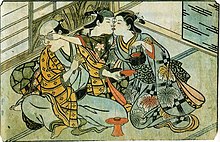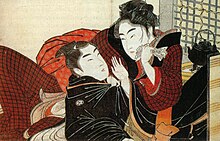Kagema

Kagema (陰間) is a historical Japanese term for young male prostitutes. Kagema were often passed off as apprentice kabuki actors (who were themselves often prostitutes on the side) and catered to a mixed male and female clientele. For male clients, the preferred service was anal sex;[1]: 109 homosexual fellatio is almost unmentioned in Tokugawa-era documents.[1]: 121–122 Kagema who were not affiliated with an actual kabuki theatre could be hired through male brothels or those teahouses specializing in kagema.[1]: 69–72 Kagema typically charged more than female prostitutes of equivalent status,[1]: p111 and associated notes and did a healthy trade into the mid-19th century despite increasing legal restrictions.[1]: 70–78, 132–134 Many such prostitutes, as well as many young kabuki actors, were indentured servants sold as children to the brothel or theatre, typically on a ten-year contract.[1]: 69, 134–135 Kagema could be presented as young men (yarō), wakashū (adolescent boys, about 10–18 years old) or as onnagata (female impersonators).[1]: 90–92

This term also appears in modern Japanese homosexual slang.
References
Bernard Faure "The Red Thread" 1998.
